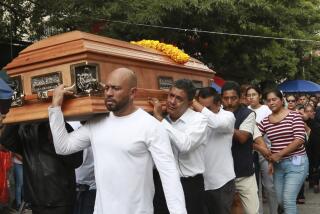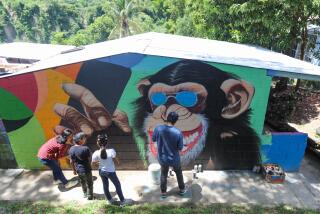Nicaragua Is Astir With Broad--and Controversial--Changes
- Share via
MANAGUA, Nicaragua — The Sandinista revolution is stirring with organizational energy these days, with the drafting of a new constitution, a new mandatory military reserve system and refurbishing of the neighborhood-based Sandinista Defense Committees.
Like much of what the Sandinistas do, these efforts are controversial. Critics contend that their ultimate goal is to help create a Marxist-Leninist system of totalitarian rule.
But the Sandinistas insist that the revolution’s goal is a constitutional democracy with freely competing political parties.
“We are not here consolidating any Marxist-Leninist model of power but rather trying to develop a new social model with a different basis,” Vice President Sergio Ramirez said recently.
The constitution is being drafted by a committee of the National Assembly, which was elected in November, 1984. Both the committee and the assembly are dominated by members of the official party, the Sandinista National Liberation Front.
A draft constitution is expected to be ready at the end of the year. It will be discussed in public meetings around the country in the early months of 1986, then debated and submitted to a vote in the assembly.
Political opponents of the government speculate that the constitution will be designed as a tool for establishing a Communist-style government in Nicaragua. But Carlos Nunez, one of the nine Sandinista “commanders of the revolution” and the president of the assembly, said that is not the Sandinista Front’s intention.
“It is not a socialist project nor is it a reformist project,” Nunez said.
‘Inflated Concern’ Seen
He and Ramirez insisted in separate interviews that the constitution will provide for a pluralist political system with competing parties, a mixed economy, with both government and private ownership, and a nonaligned foreign policy with ties to both East and West.
“Those are principles that in no way will be altered, and this opens a long-range political perspective for the country,” Ramirez said.
He added that the opposition’s fear of Marxist-Leninist radicalism in the revolution “is an inflated concern, inflated by the government of the United States.” The Sandinistas have had “more than enough” pretext for radicalizing the revolution if they had wanted to do so, he said.
“I think we would need few pretexts to say, ‘All right, the United States mines our ports, the United States supports terrorists, the United States imposes an embargo on Nicaragua and declares an economic boycott, the United States finances the counterrevolution, the United States maintains a counterrevolutionary army in Honduras and therefore there are no other possibilities here except a socialist, Marxist-Leninist state’--those pretexts are there.”
But, he added, “we do not aspire to a political-economic system of that kind.”
“The fact that here the Marxist ideology is not a persecuted ideology--and Marxists can be found in the government or in the Sandinista Front--that does not mean that our political project is to take the country toward a one-party regime, abolition of private property and a Leninist framework of power,” he said. “The constitution has totally different lines--of pluralism.
“Of course, the functioning of that pluralism is a concrete problem. We are going to lay the foundations. How perfect a democracy can be in Nicaragua depends on other circumstances. And that is not resolved from one day to the next.”
Critics of the revolution argue that the Sandinistas are developing mass organizations and military structures to strengthen their grip on the society.
In October, the government announced that all men between the ages of 25 and 40 would be required to register for the army reserve. Officials have indicated that about 40% of those who register will be organized into reserve units, which will be trained for 30 days a year and will be subject to induction to active duty.
The government says the mandatory reserve is needed to defend the country against U.S. aggression.
Ulises Somarriba, secretary general of the opposition Independent Liberal Party, said the reserve will also help the Sandinistas control an important sector of the society. “With this, they consolidate their hegemony more,” Somarriba said.
A foreign diplomat agreed, saying: “Obviously, if you militarize that many people, you have better control over them.”
The diplomat said the main Sandinista tool for controlling Nicaraguans is the Sandinista Defense Committees, known by the Spanish initials CDS. The Sandinistas contend that the defense committees are community self-help organizations, and that they are being reoriented to emphasize that role.
“That is a smoke screen,” the diplomat said. He said the Sandinistas are worried that anti-revolutionary groups might gain strength on the community level and are therefore trying to increase the strength of the defense committees.
Ramon Martinez, secretary general of the opposition Social Democratic Youth organization, said the neighborhood committees are already powerful.
“The CDSs maintain absolute control over their neighborhoods,” Martinez complained.
He charged that defense committees “exercise psychological pressure on the population” by harassing opponents of the government. Martinez and other critics said that committee informers help the police, regulatory agencies and military draft authorities carry out selective enforcement campaigns against the opposition.
Officials acknowledge that the committees have committed errors and abuses in the six years since the Sandinistas came to power. As a result, the officials admit, the committees have lost popularity.
Milagros Leyton, a member of the national executive committee of the Sandinista Defense Committees, said active membership has dwindled to about 300,000 from a peak of about 500,000.
“There were some leaders that adopted authoritarian, arrogant and coercive attitudes,” Leyton said, and added that many defense committee projects were imposed from above, giving grass-roots members little say in deciding what their committees would do.
Leyton said the new orientation of the CDS is for individual block committees to choose their own projects, “for the people to identify with the organization and participate.”
Committee Projects Vary
Projects could be anything from starting a communal vegetable garden to carrying out a campaign against infant diarrhea.
Work in defense committee projects is voluntary, Leyton said, and neighborhood residents are invited to participate through the door-to-door “persuasive labors” of members.
“It is not pressure; it is a chat,” Leyton said. “You try to convince the person to participate. If they do, fine, and if they don’t, fine.”
There have been committee meetings in the past few weeks to discuss the new orientation and elections are being held for new local officers. National leaders say it does not matter whether those elected are members of the Sandinista Front.
Leyton said “revolutionary vigilance” will remain a part of defense committee work, but that does not mean spying on neighborhood residents. She said committees operate like neighborhood crime-watch organizations in the United States, trying to prevent common crimes, vandalism and anti-revolutionary sabotage.
Vice President Ramirez said the changes in the Sandinista Defense Committees will be “very profound.”
“We don’t need the CDSs to be blind instruments of revolutionary power,” he said. “It has been proved that it doesn’t work for us, because something organized from above doesn’t work for us.”
More to Read
Sign up for Essential California
The most important California stories and recommendations in your inbox every morning.
You may occasionally receive promotional content from the Los Angeles Times.













